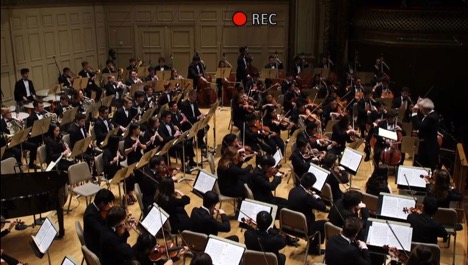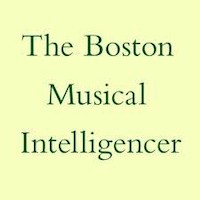BPYO Fantastique Stream Shows Possibilities

As “a malign miasma stalks the land and there’s a palpable tension in the air,” (to quote a notice we received from an organization in the UK), public life is galloping to a standstill, nowhere more evidently so than in public artistic life. As these pages have been noting over the past week, many concert organizations have been either postponing or canceling their events, or have taken the somewhat more imaginative step of keeping the public away from concert halls while performing their programs for a home audience via live stream. One such performance was attempted last night by the Boston Philharmonic Youth Orchestra under Benjamin Zander. To a largely empty Symphony Hall (family and friends of the orchestra were admitted) this acclaimed ensemble took on the ambitious program of Stravinsky’s Petrushka and Berlioz’s Symphonie Fantastique.
This is not really a review of that performance, but some observations on how the experience of seeing a live performance online might or might not satisfy the cravings of music-starved audiences. For the record, however, we were quite impressed with what we heard and saw from these fine young musicians (it did appear that, perhaps in light of some players’ reservations about sitting so close on stage to others in the orchestra, there were some performers who were probably beyond the normal age range of the ensemble).
“The playing was crisp, the ensemble tight, Zander’s direction was intense and driven, and the players charged with solo roles were all spot on.”
It would be nice if the full program book had been made available so we could see who these folks were, a thought for all those using this type of presentation facilities.
Zander, ever the convivial presenter, made excellent use of the skills of his second profession as an inspirational speaker to introduce the circumstances surrounding the unusual performance, with a touching tale of how his father in later life turned to live radio performances as a substitute for the concerts he could no longer attend. As much a pep talk for the orchestra as an explanation for the unseen audience, it seemed to serve its purpose well. We were reminded by something in this morning’s paper about the excitement felt by performers in the days of live television, only heightened by the absence of a studio audience.
It must be admitted that our experience was tempered by a number of factors. First off, as probably the case with most of us, our home desk computer, while not forced to rely on its internal speakers, is not hooked up to what one could call an audiophile sound system (we did verify, though, that the sound was better than what came from our headphones, especially when we were positioned a few feet back). The streaming facilities at Symphony Hall are pretty advanced in terms of sound and video capture, which might not be the case in other venues: long shots and close-ups were well alternated and could range pretty well among orchestral sections and individuals. The long-shot covered about 90% of the orchestra, but close-ups were able to bring in the missing at the corner, notably the pianist in the Stravinsky and the harpists in the Berlioz. While it’s hard to make definitive statements about sound quality considering the state of our receiving equipment, whatever compression was used in the transmission was not so noticeable that it precluded effective dynamic contrasts, and indeed there were some thrilling moments in which Zander and the orchestra went from fortissimo to pianissimo instantly.
When it was going, we experienced no difficulty with the stream itself, at what our ISP assures us is a 250 mbps download speed. Reliance on technology other than your own five senses does occasionally present problems, though, and we’re sorry to have to report that, for reasons unknown, the stream cut off at precisely 8:30 pm, in the middle of the wonderful trumpet solo in Petrushka. After a while, it seemed that that would be that. However, a second stream was established after about 20 minutes, by which time of course the Stravinsky had concluded, and intermission was in progress. One wouldn’t know about the new stream without checking the comments below the streaming window, after sitting patiently for that period, which the viewer numbers suggested only a minority of viewers did. The new stream held up to the end, but those missing minutes of Stravinsky remain missing as of this writing. For those who gave up, the Berlioz performance can be located [see below] and is well worth seeing. The link for Stravinsky’s fantuccio interrotto is [see below].
It can be expected (well, hoped anyway) that more Boston organizations will take the live-streaming route despite the financial hit of lost ticket sales. Meanwhile, for a mostly New York-centric listing of streaming opportunities, the New Yorker’s Alex Ross has compiled a listing.
 Vance R. Koven - The Boston Musical Intelligencer
Vance R. Koven - The Boston Musical Intelligencer